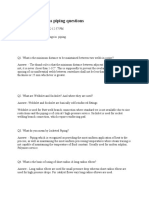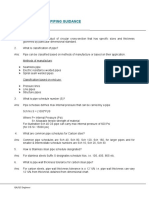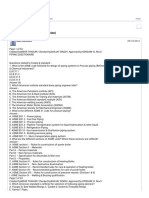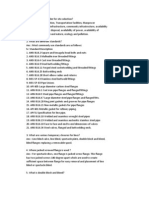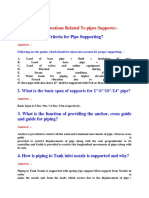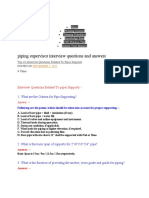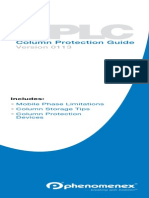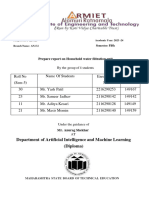Piping Question and Answer
Piping Question and Answer
Uploaded by
Mohammed Abdul MoqeetCopyright:
Available Formats
Piping Question and Answer
Piping Question and Answer
Uploaded by
Mohammed Abdul MoqeetOriginal Description:
Copyright
Available Formats
Share this document
Did you find this document useful?
Is this content inappropriate?
Copyright:
Available Formats
Piping Question and Answer
Piping Question and Answer
Uploaded by
Mohammed Abdul MoqeetCopyright:
Available Formats
PIPINGQUESTIONARY
MANZARUL KHAN
1) What is punch list?
List of unfinished work or unmatched item according to DRWG and specifications before Hydro- test.
2)What is the Reason for installing a loop in piping?
To ease Expansion and contraction of pipe due to fluid temperature change.
3)What is the Insulation Kit?
To isolate between above ground and underground.
4)Type of Supports :
Spring support, Hanger support, Dummy support, Shoe, Anchor, Guide and Pick up.
5) Check valve: Designed to permit flow of liquid or gas in a one direction and close if flow reverses.
5) Steam Tracing: To prevent fluid from congealing, forming hydrates, condensing, interfering with operation or
causing any damage to piping, equipment and instrument.
6) Vents: Are needed to let gas usually air in and out of service. Basically to remove air pockets from the line.
7) Support types are defined as follows:
a) Anchor a support fixing the piping completely.
b) Guide a support restricting the movement perpendicular to pipe axis, but the axial
movement is allowed.
c) Hanger a support hanging the piping.
d) Spring a resilient support which allows vertical movement.
e) Resting support a simple support bearing the pipe weight only.
f) Directional stop a support restricting the movement of a certain direction.
g) 3way restraint - a support restricting the movements of three directions, but permitting
rotation.
h) Pick up support - a support resting small diameter pipe using large diameter pipe instead of steel structure.
8) Threaded joints checklist:
a) What is the maximum diameter piping allowed in hazardous service (1.1/2)
b) What is the minimum sized piping that can be installed on pipe racks (1)
9)How many threads can be visible after seal welding threaded joints?
Zero. Seal welding must cover all threads.
10) What is the gap requirement for socket welds for new construction?
1.5 mm to 3.0 mm gap prior to welding.
11) What is a guide?
It controls the horizontal movements of the pipe.
12) Clearances:
a) 50 mm rule between all piping and supports.
b) 24 clearance from supports, dead legs, drain and vents.
c) 300 mm from grade at all piping.
d) Fittings, butt welds, etc, adjacent to hangers, clamps, supports, etc must be spaced to allow
PIPINGQUESTIONARY
MANZARUL KHAN
freedom of piping movement. Alternatively, flush grind and NDT can be allowed as long as weld location will not
restrict piping movement
13) Drip legs: Often made from pipe and fittings, the drip leg is an inexpensive means of collecting condensate.
Removal of condensates from steam lines.
14) Piping and Instrument diagram: This drawing is commonly referred to as the P & ID. Its object is to indicate all
process and service lines, instrument and controls, equipment and data necessary for the design group. The process
flow diagram is the primary source of information for developing the P&IDS.
15) An Inspection & Test Plan?
A mandatory item in the quality plan that guides and assures quality in a Specific type of work in basic sequence of
QC activity steps.
16)A Quality Control Procedure?
A document that details the specific steps needed to fulfill the QC activity in the ITP.
17) Quality control form?
A written documentation detailing a specific activity in the ITP & QC procedure
18) What is a specification?
A specification is a guide line to assure that minimum Quality standards are met.
19) What types of inspection action points are found in the ITP?
Hold, Witness, Surveillance, Review.
20) What are the differences between the 4 types of inspection points?
Detail answer and ensure a clear understanding by candidate.
21) What is a P & ID?
Piping and instrument diagram will show the piping layout and detailed notes relating to piping and instrumentation.
22) What is SIS?
Safety Instruction Sheet that gives full design details related to a piping system or Line.
23) What is a piping system?
Describes the specific service or fluid.
24) What is the piping line class designation?
A specific name in alphanumeric designation describes features of a piping system.
25) Show example of a line designation from isometric drawing?
ICS1P3 =150#class, Carbon Steel, 1/16 CA, General hydro carbon.
26) What is an isometric drawing?
A detailed piping system / line drawing with reference to construction and material Requirements
PIPINGQUESTIONARY
MANZARUL KHAN
27) What things are found in a piping isometric drawing?
Line conditions, references to drawings, materials of construction, elevations, Orientation, piping and drawing details
and notes, revision control and approval Status.
28) What is a Material list or Material Take off Sheet ( MTO )?
Details of materials used in construction of piping, using with isometrics.
29) What is a PIP?
Process Industry Practice details requirements for fabrication an Industry Practice. These are often the basis for SA
standards.
30) Material Inspection:
a) How do you verify the material? And mention several items to check.
Mill Certificate, heat number, color coding and PMI, schedule, rating, Carbon equivalent
Value for PREHEAT, diameter, class, grade.
b) How do you identify fitting and flanges?
Correct ratings, sizes, class, schedules as marked on fittings & mill certificates.
c) How do you check piping for the correct schedule?
Use a Vernier Caliper and ensure piping is within tolerances.
d) What are the tolerances for physical piping straightness and defects?
Check the ASTM or API piping specification.
e) What is standard mill tolerance for piping?
87 % (all) to 115% (greater than 2), 120% (2 & less) of nominal
f) How to check Valves of the correct rating and material.
CMTRs & trim during Valve testing (Visual inspection)
31) What kind of the inspection required during Gasket installation?
Check the Gasket material as per the drawing and specification, size, rating and visual Inspection of surface
damages.
32) Explain Spectacle plate:
Used for Service and shutdown (isolation) for maintenance purposes.
33) What is J ack Screws and when are they required?
They are located at flanged connections to facilitate maintenance and removal of flange and
Orifice plates to facilitate maintenance.
34) What item to be checked during orifice flange fabrication?
Flush Grinding of butt welds of the orifice flange inside and seal welding of orifice tapping Pipes.
35) What are the NDT methods are required during orifice flange installations?
Visual and PT / MT.
PIPINGQUESTIONARY
MANZARUL KHAN
36) Check list for Reinstatement:
#Check that correct bolts and gaskets are installed at all reinstated joints completed and recorded.
#Check that all process blinds and spades have been correctly installed as indicated on the
P & ID.
#Check that spectacle blinds are in the correct position.
#Check that correct valves have been installed in the correct Flow position.
#Check that specified block valves have locking devices correctly installed.
#Check that all valves are functioning properly and that spindle has been coated with copa-slip
are equal there specified.
#Check that relief valve have been correctly installed.
#Check that all pump suction strainers have been correctly installed.
#Check that correct flow through filters, and strainers, traps, check valves and globe valves.
#Release for final equipment alignment.
#Hydro test completed.
37) HYDRO TEST PACKAGE REVIEW:
1) P&ID for correct revision.
2) Isometric drawing for correct revision.
3) Isometric Drawing confirm to P&ID.
4) Boundaries of hydro test, filling / draining / vent point and ensure all necessary P & IDs /
Isometric are in the package.
5) Ensure all line listed in test package are identified and test pressure is correct as per LDT.
Check blind lists of sizes, thickness and rating.
6) Check exception list.
38) THE CONTENTS OF TEST PACKAGES ARE:
1) Marked up P&ID and isometric drawings showing the location and type of pipe supports, the boundaries of the test,
valve position and the location of Vents, drains, temporary blinds (size and thickness), the water fill point And
pressure gauges.
2) The test medium and pressure.
3) A piping line list.
39)THE CHECK LIST FOR PIPING WORK COMPLETION NEEDS TO BE CONFIRMED BEFORE THE
PRESSURE TEST CAN COMMENCE:
CHECK LIST IS AS FOLLOWS:
PIPINGQUESTIONARY
MANZARUL KHAN
1) Piping should be Correct Dimension, Location and Orientation.
2) Welding Completed.
3) NDE Completed.
4) PWHT and Hardness Test Completed.
5) Valve, in line item and line Equipment Completed.
6) Support and Hanger installation Completed.
7) Material Thickness Verification / Color Code
8) P&ID Walk through in accordance with Isometric drawings.
9) All instruments are disconnected or not.
40) BEFORE THE TESTING COMMENCES SOME OF THE GENERAL REQUIREMENT TO BE CHECK AND
REVIEW.
1) Test Pressure to be used shall not less than 1.5 times the design pressure.
2) Water to be used shall be fresh water and free from sediments. The Maximum Chloride
content shall be less than 30 ppm.
3) For Pneumatic testing, the test medium shall be Air or any other non-flammable gas and the test pressure shall
be 110 % of the design pressure. For pneumatic test, the soap solution spray shall be used during leakage detection.
4) The Temporary supports are to be examined to ensure that they will adequately support the line during testing.
41)TEST SEQUENCES ARE:
1) Filling Test System Completely with water or Air.
2) Fill the water from the down side.
3) Open all vent valves during Water filling.
4) Applying pressure gradually until the specified test pressure is reached.
5) Holding time is 10 minutes minimum. The test pressure is attained until all welds and
connection have been examined (Shall not over pressurize the system).
6) After the test, the system was drained to minimize standing water in the line. Air blowing to be performed to
remove the remaining water.
42)VALVE INSPECTION AND TESTING: (API 598)
The following tests and examinations are specified in this standard.
a) Shell Test.
b) Back Seat Test.
c) Low Pressure Closure Test.
d) High Pressure Closure Test.
e) Visual Examination of Castings.
43)THREE ADVANTAGES OF USING STUD BOLTS ARE :
1.The stud bolt is more easily removed if corroded.
2.Confusion with other bolts at the site is avoided.
3.Stud bolts in the less frequently used sizes and materials can be readily made from round stock.
44) ACCEPTANCE CRITERIA FOR INSPECTION OF 6 DIA, SCH. 40 BUTT WELD J OINT:
a) Bevel Angle . 37.5 (tolerance 2.5)
b) Root Gap... 1.6mm (tolerance 0.8mm)
c) Internal Alignment (Hi- Lo) 1.6mm below.
d) Root Face...1.6mm (tolerance 0.8mm)
PIPINGQUESTIONARY
MANZARUL KHAN
45) TWO REASONS FOR HAVING VENT HOLE ON REINFORCING PAD OF BRANCH
CONNECTION :
To reveal leakage in the weld between branch and header.
To allow venting during welding and heat treatment
46) Non corrosive fluids
Services where impurities are accepted industrial water lines (cooling water) steam lube oil return / before filter lines
air lines vents and drains
Carbon Steel, Low Alloy Steel (High T)
47) Corrosive fluids
Services where impurities are not accepted demineralized water lube oil after filters
fuel gas / oil sea water (water containing Chlorine) Stainless Steel No Iron (Fe)
Copper/ Nickel Alloys (Cu- Ni)
48) Give typical material specifications for
CS flanges : A105 forgings / A 216 Gr. WCB castings / A 515 Gr.70 Plates.
SS flanges : A 182 Gr.F304 - forgings / A 351 Gr.CF3 - castings / A 240 Gr.304 Plates.
LTCS flanges : A 350 Gr. LF3 forgings / A 352 Gr. LC3 castings / A 203 Gr.E Plates.
AS flanges : A 182 Gr.F11 CL 2 - forgings / A 217 Gr.WCB - castings / A 387 Gr.11 CL.2 Plates.
49) What is the difference between
(1) SS 304 and SS 304 L - 304 L is low Carbon C 0.03%.
(2) SS 304, SS 316 and SS 321.
SS 304 18 Cr. and 8 Ni.
Where as SS 316 contains Molybdenum 2 to 3 %.
SS 321 as the same chemical composition of SS 304 but in addition to that it contains Ti which is a stabilizer
50) What is the function of a steam trap?
Function of the Steam trap is to remove the condensate.
51) What are the 3 precautions that has to be taken during the welding of Orifice flanges ?
1) Welding nearer to the flanges shall be flush ground to avoid any turbulence.
2) The orientation of the tapping holes shall be maintained.
3) No bends shall be available nearer to the flange it shall be straight for a distance of atleast 5 times the Diameter of
the pipe on the Up stream.
PIPINGQUESTIONARY
MANZARUL KHAN
YERP-SAES-L-100 APPLICABLE CODES AND STANDARDS FOR PRESSURE PIPING SYSTEMS
YERP-SAES-L-105 PIPING MATERIAL SPECIFICATION
YERP-SAES-L-108, SELECTION OF VALVES
YERP-SAES-L-109, SELECTION OF FLANGES, STUD BOLTS AND GASKETS
YERP-SAES-L-110 LIMITATIONS ON PIPE J OINTS AND COMPONENTS
YERP-SAES-L-120 PIPING FLEXIBILITY ANALYSIS
YERP-SAES-L-125 SAFETY INSTRUCTION SHEET FOR PIPING AND PIPELINES
YERP-SAES-L-130 MATERIAL FOR LOW TEMPERATURE SERVICE
YERP-SAES-L-131 FRACTURE CONTROL OF LINE PIPE
YERP-SAES-L-132 MATERIAL SELECTION FOR PIPING SYSTEMS
YERP-SAES-L-133, CORROSION PROTECTION REQUIREMENTS FOR PIPELINES, PIPING AND PROCESS
EQUIPMENT
YERP-SAES-L-136 SELECTION AND RESTRICTIONS OF CARBON STEEL PIPE
YERP-SAES-L-140 THERMAL EXPANSION RELIEF IN PIPING
YERP-SAES-L-150, PRESSURE TESTING OF PLANT PIPING AND PIPELINES
YERP-SAES-L-310 DESIGN OF PLANT PIPING
YERP-SAES-L-350 CONSTRUCTION OF PLANT PIPING
YERP-SAES-A-004 GENERAL REQUIREMENTS FOR PRESSURE TESTING
YERP-SAES-A-005 - SAFETY INSTRUCTION SHEET
YERP-SAES-A-007 HYDROSTATIC TESTING FLUIDS AND LAY-UP PROCEDURES
YERP-SAEP-351 BOLTED FLANGE J OINTS ASSEMBLY
YERP-01-SAMSS-Y020 BASELINE THICKNESS MEASUREMENT
You might also like
- 228-90475V Sil-20a 20ac 20aht 20acht Im enDocument318 pages228-90475V Sil-20a 20ac 20aht 20acht Im encamilapasquali89No ratings yet
- Aramco Interview QuestionsDocument3 pagesAramco Interview QuestionsMd Sharique80% (5)
- Saudi Aramco Piping QC Inspector Sample Interview QuestionsDocument6 pagesSaudi Aramco Piping QC Inspector Sample Interview QuestionsRichard Periyanayagam89% (9)
- Aramco Interview Questions PRDocument11 pagesAramco Interview Questions PRhemant1284100% (4)
- Interview Questions For QAQC MechanicalDocument33 pagesInterview Questions For QAQC MechanicalBalakumar95% (357)
- Welding Inspector Interview QuestionsDocument5 pagesWelding Inspector Interview QuestionsValli Raju91% (23)
- Piping Inspector QuestionsDocument7 pagesPiping Inspector Questionsnike_y2k100% (1)
- IMA Blistering BrochureDocument8 pagesIMA Blistering BrochureTue100% (1)
- Guide For Refinery InspectionDocument50 pagesGuide For Refinery Inspectiondiaccessltd_17172961100% (9)
- QC Piping Inspector Notes Part-IDocument39 pagesQC Piping Inspector Notes Part-Imanojballa100% (4)
- Piping Inspector QuestionsDocument10 pagesPiping Inspector QuestionsRichard Periyanayagam100% (2)
- Aramco Piping QuestionsDocument6 pagesAramco Piping Questionschandu666creator90% (10)
- Aramco Exam QusDocument23 pagesAramco Exam Qussarath100% (3)
- LINE Pipes - QuestionsDocument2 pagesLINE Pipes - QuestionsTariq Hussain79% (14)
- 300+ TOP PIPING Engineering Interview Questions and Answers PDF PIPING Engineering Interview QuestionsDocument20 pages300+ TOP PIPING Engineering Interview Questions and Answers PDF PIPING Engineering Interview Questionssteepa22100% (1)
- Piping Inspector Questions - 1Document6 pagesPiping Inspector Questions - 1Sreejith Sreeraman100% (2)
- Piping Interview Questions - IIDocument45 pagesPiping Interview Questions - IIFirasat Ali60% (5)
- API 570 Exam June 1Document24 pagesAPI 570 Exam June 1Sudarshan79% (14)
- Question & Answers For Coating ExamsDocument17 pagesQuestion & Answers For Coating Examsshoaib1985100% (1)
- Evapco Evaporative Condenser Engineering Manual 1 1 PDFDocument32 pagesEvapco Evaporative Condenser Engineering Manual 1 1 PDFImpulsora DemaNo ratings yet
- Piping Inspector Questions 1Document6 pagesPiping Inspector Questions 1Badiuzzama786100% (1)
- Piping QuestionnaireDocument10 pagesPiping QuestionnaireRahman100% (2)
- Piping QC Guide (For Saudi Aramco Project)Document11 pagesPiping QC Guide (For Saudi Aramco Project)Heng100% (1)
- Saudi Aramco Piping QC Inspector Sample Interview Questions & Answers..Document5 pagesSaudi Aramco Piping QC Inspector Sample Interview Questions & Answers..Ch SIB100% (1)
- UG Piping, Hydro QC List-InterviewDocument6 pagesUG Piping, Hydro QC List-InterviewSyed M. Imran Ali100% (1)
- Aramco Welding Inspector InterviewDocument18 pagesAramco Welding Inspector InterviewTurbo Snail R100% (6)
- QDocument12 pagesQJoseph Peter100% (1)
- QC Questionery. PIPINGDocument6 pagesQC Questionery. PIPINGMd Sharique100% (3)
- General QuestionnaireDocument9 pagesGeneral Questionnairehemant1284No ratings yet
- Piping Latest Aramco QuestionsDocument2 pagesPiping Latest Aramco Questionschandu666creator0% (1)
- All Combine Merged Questions CBT Welding and PipingDocument57 pagesAll Combine Merged Questions CBT Welding and Pipingdada shaik100% (13)
- Interview QuestionDocument27 pagesInterview Questionsivacwi75% (4)
- Piping Interview Questions-Process Piping CourseDocument4 pagesPiping Interview Questions-Process Piping CourseUnbelievable VideosNo ratings yet
- Piping Interview QuestionsDocument17 pagesPiping Interview Questionsprasanth100% (6)
- Important Process Piping QuestionsDocument12 pagesImportant Process Piping Questionspratap biswas100% (1)
- Piping QuestonaryDocument25 pagesPiping QuestonarySanjay Kumar yadav100% (4)
- Piping Engineers Interview QuestionsDocument16 pagesPiping Engineers Interview Questionsashish2086100% (2)
- Piping Interview QuestionsDocument21 pagesPiping Interview QuestionsPradeep Beserwal100% (3)
- Piping Q.C Ag& UgDocument12 pagesPiping Q.C Ag& UgGokulPrasad88% (8)
- Piping Q & ADocument8 pagesPiping Q & Avenkatesh100% (1)
- Aramco CBT Questions-Answere For QAQC WeldingDocument10 pagesAramco CBT Questions-Answere For QAQC WeldingAbdul Hafeez100% (2)
- RTR Pipe Interview QuestionsDocument1 pageRTR Pipe Interview QuestionsMd Sharique100% (1)
- PIPING QUESTIONAIRE (Interview) - Google Groups PDFDocument11 pagesPIPING QUESTIONAIRE (Interview) - Google Groups PDFKurian Jose100% (1)
- CBT QuestionsDocument5 pagesCBT QuestionsAris Bulaong100% (2)
- Welding Inspector - IntDocument5 pagesWelding Inspector - IntMidhun K Chandrabose100% (7)
- Drawings: Md. Habib Naukhez Gulf Asia Saudi ArabDocument13 pagesDrawings: Md. Habib Naukhez Gulf Asia Saudi ArabRaheel JibranNo ratings yet
- Piping, Hydro QC List-InterviewDocument8 pagesPiping, Hydro QC List-Interviewtayyab100% (1)
- Jiteendra Piping ForemanDocument7 pagesJiteendra Piping Foremanhitanshu100% (1)
- Piping QuestionsDocument57 pagesPiping Questionsnavee_200875% (4)
- Piping-Cbt Question With Answer.Document1 pagePiping-Cbt Question With Answer.Md Sharique100% (8)
- CBT Piping QuestionsDocument4 pagesCBT Piping Questionsshaijukv100% (1)
- Aramco Piping Inspector Question and AnswersDocument11 pagesAramco Piping Inspector Question and AnswersSURESH NAIRNo ratings yet
- Interview Questions Related To Pipes Supports:-: 1. What Are The Criteria For Pipe Supporting?Document15 pagesInterview Questions Related To Pipes Supports:-: 1. What Are The Criteria For Pipe Supporting?Mayur Mandrekar100% (1)
- Welding Inspector Interview QuestionsDocument5 pagesWelding Inspector Interview Questionsவிஷ்ணு ராஜசெல்வன்No ratings yet
- Questions Related To CodesDocument10 pagesQuestions Related To CodesMayur Mandrekar100% (1)
- Interview Mech Piping SuperDocument17 pagesInterview Mech Piping SuperUdayakumarNo ratings yet
- Piping CBT Latest Notes 27 Feb 2024Document26 pagesPiping CBT Latest Notes 27 Feb 2024AMALENDU PAUL100% (1)
- Aramco Q&aDocument5 pagesAramco Q&aEzhil Arasan100% (3)
- Piping, Hydro QC List-InterviewDocument3 pagesPiping, Hydro QC List-InterviewAnonymous 4e7GNjzGW100% (2)
- Piping InterviewDocument9 pagesPiping Interviewsatyammmishra0101No ratings yet
- Piping Final ExamDocument11 pagesPiping Final ExamAhmed HaridiNo ratings yet
- Inline Hydro TestDocument7 pagesInline Hydro TestjeswinNo ratings yet
- Piping Layout PresentationDocument56 pagesPiping Layout Presentationhirenkumar patel90% (10)
- Check List For IsometricsDocument4 pagesCheck List For IsometricsashokNo ratings yet
- Suvidya Book1Document113 pagesSuvidya Book1amankodi50% (2)
- Strong or WeakDocument1 pageStrong or WeakMohammed Abdul MoqeetNo ratings yet
- Greedy Boy - A Short Moral Story For Kids: Greediness Will Make You Lose EverythingDocument1 pageGreedy Boy - A Short Moral Story For Kids: Greediness Will Make You Lose EverythingMohammed Abdul MoqeetNo ratings yet
- Lion and The MouseDocument1 pageLion and The MouseMohammed Abdul MoqeetNo ratings yet
- Workplace Stories: in The Eyes of Your Boss, It's A Dog's Life After AllDocument5 pagesWorkplace Stories: in The Eyes of Your Boss, It's A Dog's Life After AllMohammed Abdul MoqeetNo ratings yet
- Analytical Chemistry Back Titration: Al-Farabi College University Petroleum Engineering DepartmentDocument4 pagesAnalytical Chemistry Back Titration: Al-Farabi College University Petroleum Engineering DepartmentlaithjnbNo ratings yet
- Centrifugal Pump Piping Design LayoutDocument19 pagesCentrifugal Pump Piping Design Layoutvijayakumar2015No ratings yet
- Fundamentals of Cavity PreparationDocument76 pagesFundamentals of Cavity Preparationragakodali0% (1)
- Fundamentals Physics M2: Cat ADocument132 pagesFundamentals Physics M2: Cat AaideebNo ratings yet
- REVIEWDocument9 pagesREVIEWsandrasusan2722No ratings yet
- HPLC - Column Protection GuideDocument46 pagesHPLC - Column Protection GuideRafael CavalcanteNo ratings yet
- Est Final ReportDocument16 pagesEst Final Reportkapoor10564No ratings yet
- CIC-presentation of RP-577 PresentationDocument181 pagesCIC-presentation of RP-577 PresentationIbrahim Eldesoky80% (5)
- Specifications of UREA 46 GRANULADODocument2 pagesSpecifications of UREA 46 GRANULADOMartí Vilà VallsNo ratings yet
- CTO FullDocument98 pagesCTO FullsohailNo ratings yet
- Never Underestimate Your Fresh Water Needs: Coral Sea Key FeaturesDocument7 pagesNever Underestimate Your Fresh Water Needs: Coral Sea Key FeaturesIrda OnesNo ratings yet
- Cetrimide: Section 1: Identification of The Substance/ Mixture and of The Company/ UndertakingDocument7 pagesCetrimide: Section 1: Identification of The Substance/ Mixture and of The Company/ Undertakingnimesh desaiNo ratings yet
- Maya DermDocument2 pagesMaya DermSibhansh HasteyNo ratings yet
- Lennox G24 SeriesDocument36 pagesLennox G24 Seriesmcampext100% (1)
- Ok Vertical MillDocument8 pagesOk Vertical MillRahul Roy100% (1)
- Parasitology Recall QuestionsDocument11 pagesParasitology Recall QuestionschennielafleurNo ratings yet
- TEG Design ManualDocument15 pagesTEG Design ManualEryl Yeong100% (1)
- Adsorption of Lead On Cucumber Peel - 2017 - Journal of Cleaner ProductionDocument13 pagesAdsorption of Lead On Cucumber Peel - 2017 - Journal of Cleaner ProductionRocío Rodríguez CastroNo ratings yet
- PDF 104 Malcom Powell Common Operational Issues On Sag Mill Circuits DLDocument19 pagesPDF 104 Malcom Powell Common Operational Issues On Sag Mill Circuits DLJuanOlivaresNo ratings yet
- HB QIAamp DNA Microbiome KitDocument24 pagesHB QIAamp DNA Microbiome Kitbehrooz.rahimiNo ratings yet
- Environmental Product Declaration: Protect Feeder Terminal REF 541/543/545Document4 pagesEnvironmental Product Declaration: Protect Feeder Terminal REF 541/543/545ngocanhvyNo ratings yet
- SOLID WASTE ManagementDocument77 pagesSOLID WASTE ManagementFahmi FesoolNo ratings yet
- QCMDocument2 pagesQCMmanish_keswani01No ratings yet
- CC Crimp GuideDocument53 pagesCC Crimp Guidenajeh100% (1)
- 420 Martensitic Stainless Steel BarDocument4 pages420 Martensitic Stainless Steel BarAHMED FATHINo ratings yet


































